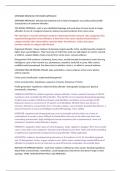OFFENDER PROFILING TOP DOWN APPROACH
OFFENDER PROFILING- behavioural/analytical tool to help investigators accurately predict/profile
characteristics of unknown offenders.
TOP DOWN APPROACH- start w pre established typology and work down to lower levels to assign
offenders to one of 2 categories based on witness accounts/evidence from crime scene.
FBI- interviews w sexually motivated murderers (ted bundy/Charles manson)- data categorised into
organised/disorganised crimes/offenders. If data from crime scene matched characteristics in
category=predict other charactetisics would be likely= find offender. Collect data about
murderer=decide on category data fits best.
Organised offender- shows evidence of planning, targets specific victim, socially/sexually competent,
higher than avg intelligence. They have type of victim they seek out, high degree of control, married
w children, weapon hidden, body removed from crime scene, conceal evidence.
Disorganised- little evidence of planning, leaves clues, socially/sexually incompetent, lower than avg
intelligence, spur of the moment act, spontaneous, impulsive, body left at scene, little control,
unskilled work/unemployed, live alone close to whether crime is, no effort to conceal evidence.
CONSTRUCTING FBI PROFILE STAGES- data assimilation- review evidence (crime scene photos,
witness reports)
Crime scene classification- orghanised/disorganised
Crime reconstruction- hypotheses, sequence of events, behaviour of victim
Profile generation- hypotheses related to likely offender- demographic background, physical
charactersitc, behaviour.
STRENGTH-SUPPORT for distinct organised category offender- Canter conducted analysis of 100 US
murderers each committed by diff serial killer. They did this to test organised disorganised typology.
Smallest space analysis statistical technique used-identifies correlations across samples of diff
behaviour=assess co occurrence of 39 aspects of serial killings. Whether there was torture or
restraint, attempt to conceal body, form of murder weapon, cause of death. Revealed that there is a
subset of features of many serial killings matched FBI typology. It has validity.
HOWEVER- organised and disorganised types are not mutually exclusive there are variety of
combinations at murder scenes. Difficult to classify killers into one or the other type they have
contrasting characteristics (high intelligence/sexual competence but is spontaneous)- more of a
continuum. Should be mixed offender category.
STRENGTH- adapted to other types of crime-burgulary. Study- applied to burglary= 85% rise in solved
cases. It also adds 2 new categories- interpersonal (offender knows their victim and steals something
of significance) opportunistic (inexperienced young offender). Wider application
LIMITATION- evidence- developed using interviews w 36 murderers in US. 24 classsified organised
and 12 disorganised. Canter- argues sample is poor- didn’t select random/large sample/diff kinds of
offender/no standard set of q in interview so each diff and not comparable. No scientific basis.
BOTTOM UP APPROACH British - work from evidence collected at crime scene= develop hypotheses
about likely characeroistics, motivations, social background. Data driven and doesn’t begin w fixed
typology. TYPES- INVESTIGATIVE PSYCH, GEO PROFILING
, Investigative psych- matches details from crime scene w statistical analysis of typical offender
behaviour patterns based on psych theory. Establish patterns of behaviour likely to occur across
crime scenes= develop statistical database to reveal important details about offender=determine
whether series of offences are linked. Interpersonal coherence- they way offender behaves at scene,
how they interact reflects behaviour in everyday situations EG SOME rapists want to maintain
maximum control over victims some are apologetic. Significance of time and place- indicate where
they are living. Forensic awareness- indidviduals who have been subject of police interrogation
before- aid concealing evidence or covering tracks.
GEO Profiling- based on spatial consistency- offenders operational base/possible future offences are
revealed by geo location of previous crimes. Uses info about location of linked crime scenes to make
inferences about likely home (crime mapping). Used in conjunction w investigative psych to create
hypotheses about how they are thinking and modus operandi.
CANTERS CIRCLE THEORY- assume offenders restrict work to geo areas theyre familiar w, the pattern
of offending forms a circle around offenders home base. Descrives offender in 2 ways-
Marauder- operates in close proximity to home base.
Commuter- travelled distance away from usual residence.
STRENGTH- OF INVESTIGATIVE- evidence support. CANTER AND HERITAGE- conducted analysis of 66
sexual assault cases- using small space analysis- helped understand how offending behaviour
changes over series of offences. Behaviours were identified as common in diff samples of
behaviour=establish whether 2 or more offences were committed by same person.
HOWEVER- case linkage depends on database wich only consists of historical crimes that have been
solved-means it was straightforward to link these crimes tog in first place=tell us little about crimes
that have few links between them=left unsolved
STRENGTH- evidence support geo- STUDY- COLLATED INFO FROM 120 MURDER CASES SERIAL
KILLERS US- smallest space analysis=revealed spatial consistency In bahviours. Location of each body
disposal site created centre of gravity as offenders start from home base and go in diff direction each
time they dispose body=creating a circular effect.
LIMITATION- geo not sufficient alone- reliant on quality of data the police provide=recording crime
not always accurate=vary between police forces= 75% not reported in first place-can this approach
be useful as it relies on accuracy of geo data. Other factors also important to create profile- timing,
age, experience. Not always lead to successful capture.
Strength-applied to wide range of cases
BIO EXPLANATIONS- HISTORICAL APPROACH ATAVISTIC FORM
Atavistic form- bio approach to offending- offenders are genetic throwbacks/primitive sub species ill
suited to conforming to rules of modern society distinguishable by facial/cranial characteristics.
Lombroso.
BIOLOGICAL- offenders lack evolutionary evelopment, savage untamed nature=impossible to adjust
to demands of civilised society=turn to crime=natural tendency=rooted in genes.
ATAVISTIC FORM- they have physiological markers are biologically determined characteristic that
make offenders physically diff from us. CRANIAL CHARACTERISTICS- narrow, sloping brow, strong
prominent jaw, high cheekbones, dark skin. Unemployment, slang, insensitivity to pain.




